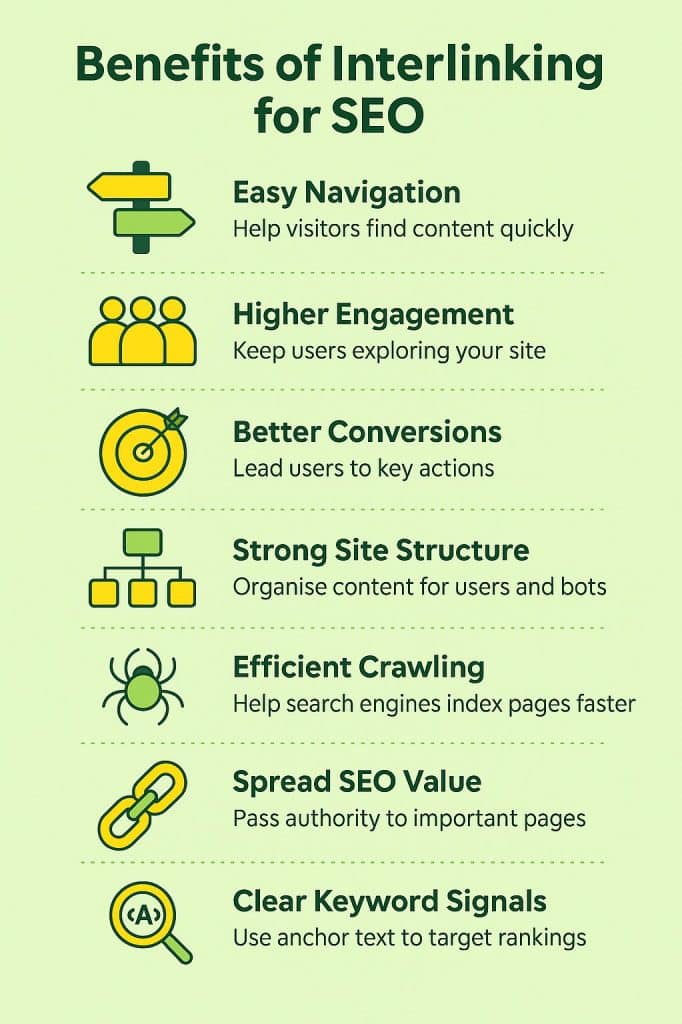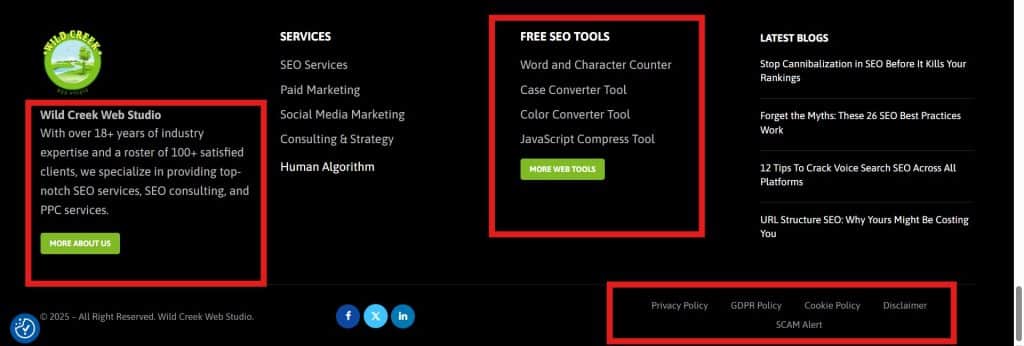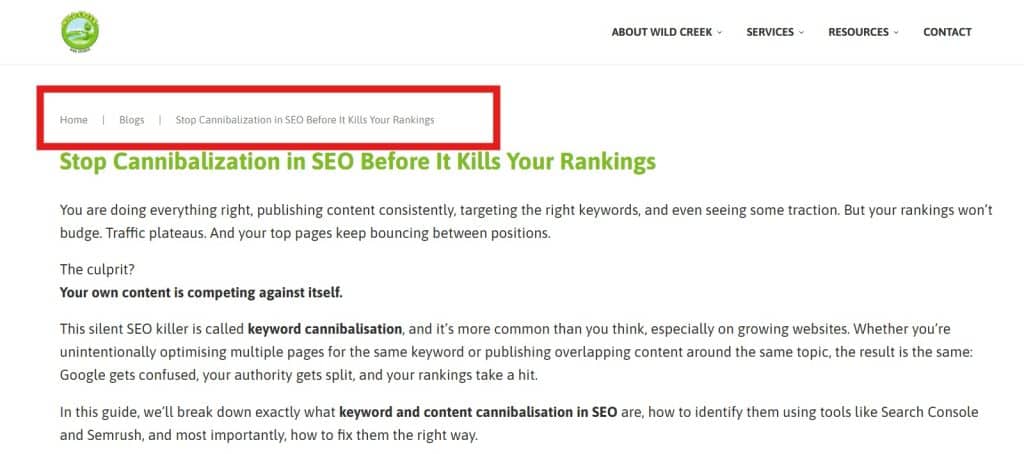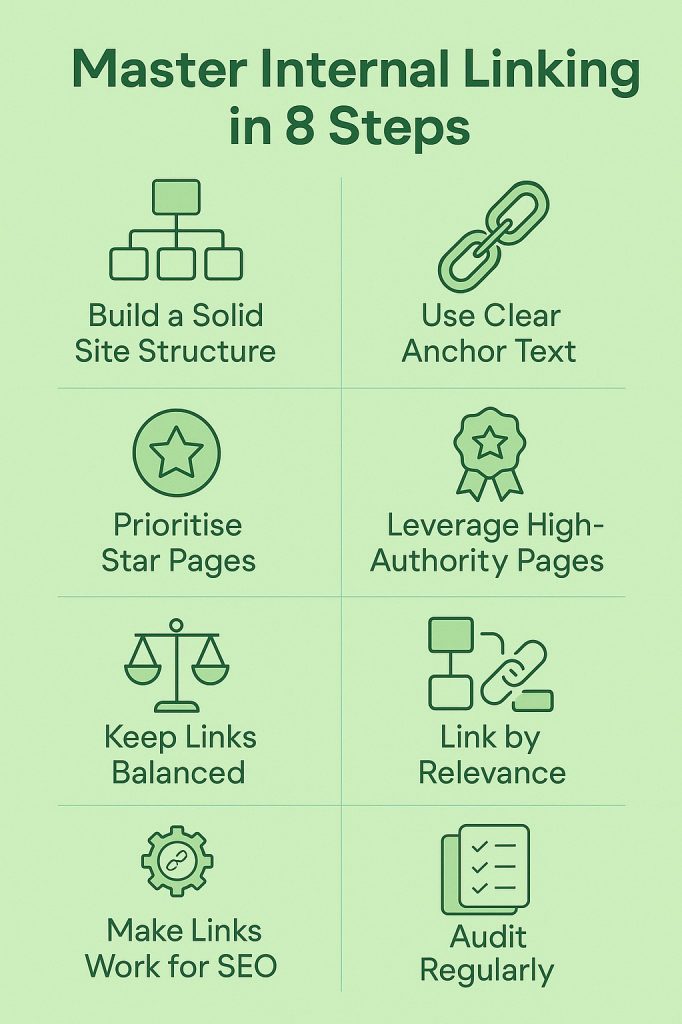TL;DR
- Internal linking connects pages within your site, improving navigation, SEO, and user engagement.
- A clear site structure, relevant anchor text, and linking to high-value pages boost rankings.
- Use different link types: navigation, contextual, breadcrumbs, footers, CTAs, and anchors.
- Follow best practices: keep links relevant, vary anchor text, avoid overlinking, and audit regularly.
- Tools like Screaming Frog, Semrush, Ahrefs, Yoast, and Link Whisper help identify and fix linking gaps.
- Wild Creek Web Studio offers audits, link mapping, anchor optimisation, and ongoing link maintenance.
Internal links in SEO are links that connect pages within your own website. They help visitors find related content and guide search engines to your most important pages.
An effective internal linking structure makes your site easier to navigate, helps spread authority between pages, and can improve your search results and rankings. Without it, valuable pages can stay hidden. With it, both people and search engines can move smoothly through your site.
This guide will walk you through best interlinking SEO practices, explain how does internal linking help SEO, and show you exactly how to improve internal linking with smart strategies, examples, and tools.
What Is Internal Linking And Its Connection With SEO?
Internal linking, also called interlinking, is the process of linking one page of a website to another page within the same domain. This is usually done by adding hyperlinks, often using HTML internal link code, that give visitors more ways to navigate and find important content. It improves the overall user experience by guiding readers through your site and reinforcing important topics and themes.
For example, your homepage might link to your main category pages, and those categories link to specific articles or products. This hierarchy is visible to search engines through reports like Google Search Console internal links and Google internal links analysis.
An HTML internal linking example would be a blog post linking directly to a related guide with descriptive anchor text.
When it comes to interlinks in SEO, they are powerful because interlinks:
- Help search engines find and index your pages so nothing important gets missed.
- Share ranking power (link equity) between your pages, which can boost your positions in search results.
- Improve user experience by leading readers to more useful or related content.
- Strengthen keyword relevance when you use descriptive anchor text in your links.
In short, internal links keep visitors engaged, help search engines understand your site, and give your content a better chance to rank higher.
Why Consider Interlinking for SEO?

Infographic showing benefits of interlinking for seo
A strong interlinking strategy isn’t just about linking pages together. It improves how visitors navigate your site and how search engines understand it. When implemented well, it can make your content easier to discover, more engaging, and better positioned to rank.
Here are the main benefits of internal linking:
- Make Browsing Effortless: Help visitors find exactly what they’re looking for without unnecessary clicks.
- Keep People Engaged: Encourage readers to explore more pages and spend more time on your site.
- Lead Visitors to Take Action: Guide them toward sign-ups, purchases, or other important goals.
- Create a Solid Site Framework: Organise your individual pages in a way that’s easy for both humans and bots to follow.
- Help Search Engines Work Efficiently: Ensure search engine crawlers can find and understand your content quickly.
- Spread SEO Power Across Pages: Pass ranking strength from well-performing pages to others.
- Send Clear Keyword Signals: Use descriptive anchor text to show search engines what each page should rank for.
What Are the Types of Internal Links?
Internal links come in different type and each of them plays a unique role in helping visitors and search engines move around your site. Understanding these types is essential if you want to answer the question “how does internal linking help SEO”, because each link type supports your website’s visibility and user experience in different ways.
Here are the most common types of internal links you should be aware of:
1. Navigational Links

Screenshot showing navigational link
Source
These are the number of internal links in your main site menu or navigation bar. They connect to your most important pages, such as the homepage, category pages, or key service sections. Navigational links help users find the core areas of your site quickly and show search engines your main content hierarchy.
2. Sidebar Links
Sidebar links are placed in a vertical section (usually on the left or right side of a page). They often feature related articles, top categories, recent posts, or product filters. They keep your most important content visible and encourage visitors to explore beyond the page they’re on.
3. Footer Links

Screenshot showing footer link
Source
Found at the bottom of every page, footer links provide quick access to essential information like your contact page, privacy policy, about page, or sitemap. From an SEO perspective, they ensure these pages are easily discoverable by both users and search engines.
4. Breadcrumb Links

Screenshot showing bread crumb link
Breadcrumbs are a small navigational aid that shows visitors the path they took to reach a page. For example:
Home > Blogs > Stop Cannibalization In SEO Before It Kills Your Rankings
These links help users go back to broader sections with one click and give search engines clear signals about your site’s structure.
5. Contextual Links

Screenshot showing contextual link
These are number of links placed within the main content of a page or article. They connect to other relevant pages or posts, helping readers dive deeper into related topics. For SEO, contextual links are powerful because they provide keyword-rich anchor text and strengthen topical relevance.
6. CTA (Call-to-Action) Links

Screenshot showing CTA link
These are links inside buttons, banners, or highlighted text designed to drive a specific action, such as “Sign Up Now,” “Read More,” or “Get a Free Quote.” CTA links help guide visitors toward conversion goals while also linking to important pages.
7. Anchor Links

Screenshot showing Anchor link
Anchor links allow visitors to jump to a specific section within the same page. They are especially useful for long-form content, FAQs, or guides, improving usability by letting readers skip directly to the information they want.
What Steps Should You Follow to Master Internal Linking?

Infographic on master interlinking in 8 steps
Internal linking isn’t just about adding random links to your pages, it’s about creating a clear path for both visitors and search engines to follow. Done right, it can boost your rankings, keep people on your site longer, and make your most important pages easier to find. Here’s how to make it work for you.
Below is a complete guide for the best internal linking strategy and internal linking tips that follows the best internal linking SEO practices.
1. Design a Site Structure That Search Engines Love
A well-structured site makes it easy for users to navigate and for search engines to crawl your content. The ideal setup follows a hierarchy with the homepage at the top, core category or pillar pages in the middle, and supporting articles or product pages at the bottom.
Here’s How to Make It Happen:
- Group related content under category or pillar pages.
- Use breadcrumbs to connect subpages to parent pages.
- Keep important pages no more than three clicks from the homepage.
Example:
Pillar: /seo/keyword-research
Support: /seo/keyword-research/long-tail-keywords
Support: /seo/keyword-research/free-tools
2. Turn Anchor Text Into a Click Magnet
This is where anchor text internal links SEO strategies are essential. Anchor text should clearly describe the content of the page it links to. Using relevant, keyword-rich text helps search engines understand context and improves the user’s click decision.
Here’s How to Make It Happen:
- Replace vague phrases like “click here” with meaningful anchors.
- Keep it short, ideally between 2–6 words.
- Use variations of the main keyword to avoid overuse.
Example:
- Good: Read our technical SEO checklist :/seo/technical-seo-checklist
- Bad: Click here :/seo/technical-seo-checklist
3. Give Your Star Pages the Links They Deserve
Some pages matter more for traffic, conversions, or authority. Directing more internal links to these high-priority pages ensures they receive greater visibility and ranking potential.
Here’s How to Make It Happen:
- Identify cornerstone or revenue-driving pages.
- Link to them from category hubs, homepage, and relevant articles.
- Place these links where they are easy to find.
Example:
If your SEO Audit service page (/services/seo-audit) is a top priority:
- From your SEO Basics pillar page, add a sentence like: For a complete site check-up, see our comprehensive SEO audit service.
- From a blog post about Crawl Depth Errors, include a line like: Fix internal linking issues faster with our detailed SEO audit service.
4. Use Your Winning Pages to Lift the Rest
Pages that already have high authority can share that strength internally. Linking from these top-performing pages to other key pages helps boost their ranking potential.
Here’s How to Make It Happen:
- Identify top donor pages using analytics or backlink tools.
- Add relevant links from these to priority pages.
- Maintain topical alignment when linking.
Example:
If your “Ultimate SEO Guide” has 200 backlinks, add links within the content to:
- Technical SEO checklist : /seo/technical-seo-checklist
- On-page SEO guide : /seo/on-page-seo
- SEO audit service : /services/seo-audit
5. When It Comes to Links, Less Can Be More
Keep the number of outgoing internal links balanced for both usability and SEO. Repeating the same anchor text too often or placing too many links on a page can harm both user experience and SEO value. Variation and moderation create a more natural linking profile.
Here’s How to Make It Happen:
- Use different anchor variations for the same page.
- Only link when it benefits the reader.
- Match link placement to the content flow.
Example:
Instead of always using internal linking strategy, rotate with:
- internal linking best practices :/seo/internal-linking-best-practices
- how to build internal links :/seo/how-to-build-internal-links
- guide to internal links :/seo/internal-links-guide
6. Only Link What Makes Sense
Links should connect pages that share a related topic or serve a similar user intent. Relevant linking helps build strong topical clusters and guides visitors to useful content.
Here’s How to Make It Happen:
- Build interlinked topic clusters around a pillar page.
- Link between pages that genuinely support each other’s content.
- Avoid linking to unrelated pages for the sake of SEO.
Example:
From meta descriptions guide, link to:
- title tag optimization :/seo/title-tags
- on-page SEO checklist :/seo/on-page-seo-checklist
- SEO basics guide :/seo/seo-basics
7. Make Every Internal Link Count
Identify and fix broken internal links so they don’t disrupt navigation or waste link equity. Most internal links should be follow links so search engines can crawl and pass authority. Only certain utility or duplicate pages should be nofollow.
Here’s How to Make It Happen:
- Keep all main internal links as follow.
- Nofollow only admin, login, or filtered pages.
- Avoid nofollowing links in navigation or content.
Example:
- Good: A blog post about SEO tools links to your /services/seo-audit page with a follow link so search engines can pass authority.
- Bad: A checkout page links to /cart with a follow link. This should be nofollow because it’s a utility page and not meant to rank.
8. Give Your Internal Links a Regular Check-Up
Internal linking needs regular maintenance to stay effective. Broken, outdated, or missing links reduce crawl efficiency and user experience. Use tools to find internal links to a page and check for any gaps.
Here’s How to Make It Happen:
- Run monthly link audits with SEMrush Site Audit or Screaming Frog.
- Fix or update broken links and redirects.
- Add new links to fresh content from relevant older posts.
Which Tools Can Help Improve Your Internal Linking Structure?

Infographic on Tools to improve internal linking
If you’re asking “What’s the best internal linking tool currently?” here are options:
1. Screaming Frog SEO Spider
Screaming Frog SEO Spider is a powerful website crawler that scans your entire site like a search engine. It can:
- Detect broken internal links and redirect chains
- Identify orphan pages with no incoming links
- Analyse anchor text usage and link depth
Best for: Technical SEO audits and large websites that need a detailed link structure review.
2. Semrush
Semrush is another full-featured SEO platform with an Internal Linking Report that:
- Shows which pages have too few internal links
- Recommends where to add more links
- Highlights broken or redirected links
Best for: Businesses wanting SEO insights and internal linking optimisation in one place.
3. Ahrefs
Known for its link analysis tools, Ahrefs offers a Site Audit feature that:
- Finds orphan pages and underlinked content
- Analyses internal link distribution and anchor text variety
- Flags broken internal links
Best for: Analysing link equity and finding opportunities to boost SEO for weaker pages.
4. Yoast SEO (WordPress)
Yoast SEO is a WordPress plugin that is deal for automating SEO internal linking suggestions. It offers:
- Real-time internal linking suggestions as you write
- Insights on cornerstone content and its linking structure
Best for: WordPress users who want quick, automated link suggestions.
5. Link Whisper (WordPress)
Link Whisper, another specialised plugin for bulk internal linking. It:
- Suggests multiple relevant link opportunities at once
- Lets you quickly add internal links to older posts
- Generates reports to monitor link counts per page
Best for: Large WordPress sites needing fast, large-scale link updates.
Struggling With Internal Links? Wild Creek Web Studio Can Boost Your SEO
Even the best content can struggle to rank if your site’s structure and linking strategy are not working together. Poor internal linking makes it harder for search engines to find important pages and for visitors to explore your site. Wild Creek Web Studio can help fix that.
At Wild Creek Web Studio, internal linking isn’t just an afterthought. It’s built into every SEO strategy we deliver. As part of our on-page optimisation process, we:
- Audit Your Current Link Structure – We identify broken links, missing links, and “orphan pages” that aren’t getting the attention they deserve.
- Plan a Strategic Link Map – We connect high-value pages with relevant supporting content, creating a network that boosts visibility for your most important URLs.
- Optimise Anchor Text – We make your link text clear, relevant, and varied so it works for both search engines and readers.
- Strengthen Topic Clusters – We connect related blogs, service pages, and resources so each one supports the others in rankings.
- Monitor and Refine – As your content grows, we keep your internal links fresh and updated for maximum impact.
By blending internal linking expertise with our proven SEO approach, we makes sure your website is easy to navigate, more discoverable in search results, and primed to convert visitors into customers.
Ready to give your site a stronger internal linking structure? Contact us today to get started.
Conclusion
Internal linking is more than just connecting pages. It is a deliberate strategy that shapes how search engines crawl your site and how visitors move through your content. A clear site structure, well-planned topic clusters, and relevant anchor text all work together to pass authority, improve indexing, and keep users engaged.
By combining smart linking practices with regular audits and the right SEO tools, you ensure that every web page has its place and purpose. This is not a one-time task but an ongoing process that grows with your website. When done right, internal linking can lift rankings, strengthen your site’s authority, and make your content easier to find and enjoy.
Frequently Asked Questions
How do internal links impact user experience and engagement?
Internal links directly enhance user experience by simplifying navigation and guiding visitors to related content. This keeps users engaged, reduces bounce rates, and increases the time spent on your site, all of which are positive signals for SEO.
Does Google treat internal and external links differently for SEO?
Yes, Google interprets internal links as signals of site structure and page authority within your domain, while external links influence credibility and trust. Both are important, but internal linking gives you full control over how link equity is distributed on your site.
What is the best way to audit internal links for maximum SEO benefits?
The best approach is to use site audit tools like Screaming Frog or Semrush to analyse internal link structure, identify broken links, orphan pages, and interlinking issues. Regular audits and targeted fixes ensure ongoing SEO benefits and optimal site health.
How often should I update or revise my internal links?
Internal links should be updated whenever new content is published or significant site changes occur. Quarterly reviews are advisable to ensure all important pages remain well-connected and that your linking structure continues to support SEO goals.
Can excessive internal linking harm my website’s SEO?
Yes, excessive internal linking can overwhelm users and dilute link equity, making it harder for search engines to identify important pages. Aim for a balanced, purposeful approach, avoiding both orphan pages and link overload to maintain a healthy site structure.
Should I prioritize certain pages when creating internal links?
Yes, prioritise high-value pages that drive traffic or conversions. Focus on cornerstone content and key landing pages to enhance their visibility through internal links. This approach not only boosts SEO but also guides users toward important sections of your site effectively.
How can internal linking impact user engagement on a website?
Internal linking keeps visitors engaged by leading them to relevant, related content instead of letting them exit after one page. This encourages longer sessions, increases page views per visit, and helps build trust by showing depth in your content.
How do internal links improve website navigation?
They act as signposts that connect different sections of your site, guiding users to important or related pages with minimal effort. A well-structured linking system makes the browsing experience smoother and helps search engines map your content more effectively.
What is the best internal linking strategy for a large website?
For a solid internal linking strategy, create a clear site architecture with pillar pages supported by topic clusters to cover each main subject in depth. Regularly audit links to fix broken ones, connect orphan pages, and ensure high-authority pages pass link equity to underperforming ones.
What is the best way to organize internal links on a website?
Organise links by relevance and user intent, ensuring each link adds value to the page it’s on. Place them naturally within content, group them logically in navigation areas, and prioritise linking to high-value pages that drive conversions or traffic.
How many internal links should a page have?
There’s no strict limit, but aim for enough to guide readers naturally without cluttering the page. For most long-form content, 5–20 relevant internal links is a good range.
How many internal links are too many?
If the page feels spammy, overwhelming, or hard to read, you’ve added too many. Excessive links can dilute SEO value and hurt user experience. Focus on quality over quantity.
How do you find internal linking opportunities?
Use tools like Screaming Frog, Semrush, or Ahrefs to spot underlinked pages and related content. You can also search your own site in Google using site:yourdomain.com “keyword” to find different pages to link from.
How do I create internal links using anchors?
Highlight descriptive, relevant text in your content (anchor text) and link it to another page on your site. Avoid vague phrases like “click here”. Instead, use clear keywords that describe the linked page’s topic.
What is your internal linking strategy for blog posts?
For blog posts, prioritise linking to pillar pages and relevant content within topic clusters. Use descriptive anchor text to reinforce SEO value and ensure each post is connected to the broader site structure, enhancing both authority and user engagement.
